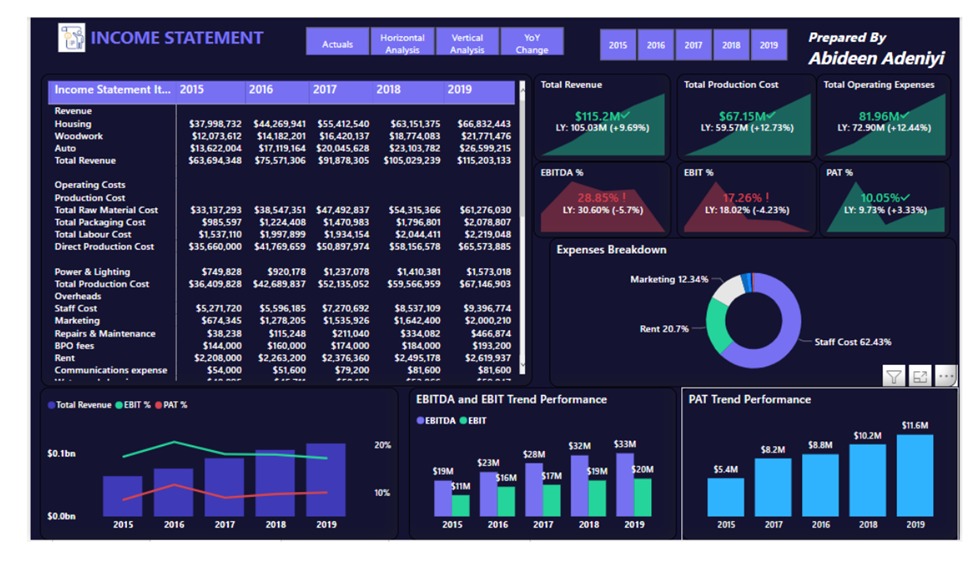Financial analytics provides in-depth insight about your company financial situation in relation to its financial visibility, profitability, and added value contributed to stakeholders.
It assists business and financial decision-makers to take proactive measures against risk and unhealthy trends and boost overall company performance. It enables you to accurately forecast future business results as well as assisting your organization to answer every related business question.
Data and Financial Analytics Series
How much impact does financial reporting analytics has on your business?
- Financial analytics has many impacts on your businesses, no matter the nature of your businesses, either small or large:
- It enables organizational leaders to have a better understanding about the risks they encountered, simplify their operations, and channel efforts towards the right and most efficient path.
- The finance functions become a problem solver by analysing how the current status might impact future operations. So organization may now make quicker, more informed business decisions because of this rapid access to information.
- Financial Planning and Predicting the future: Having financial planning and forecasting will ensure that you are aware of your company’s position and equally allow you to make better decisions that are in your company’s best interest. E,g Revenue forecasting, Expenses projections etc.
- There are many ways to cut costs for your business such as looking into your options for office space, improving productivity, keeping better track of your finances, and lowering your electricity bills by switching suppliers.
- Financial analytics has many impacts on your businesses, no matter the nature of your businesses, either small or large:
- It enables organizational leaders to have a better understanding about the risks they encountered, simplify their operations, and channel efforts towards the right and most efficient path.
- The finance functions become a problem solver by analysing how the current status might impact future operations. So organization may now make quicker, more informed business decisions because of this rapid access to information.
- Financial Planning and Predicting the future: Having financial planning and forecasting will ensure that you are aware of your company’s position and equally allow you to make better decisions that are in your company’s best interest. E,g Revenue forecasting, Expenses projections etc.
- There are many ways to cut costs for your business such as looking into your options for office space, improving productivity, keeping better track of your finances, and lowering your electricity bills by switching suppliers.
The benefits of financial analytics
To build your business, you need to make informed decisions with the data-driven insights that financial analytics can provide. Some of the benefits of financial analytics are that it:
- Agility: Uses real-time data, both external and internal, so you’re able to filter and analyze data sets quickly and easily.
- Optimized Workflows: Organizes data so it’s digestible, easy-to-understand, and provides a greater impact to your bottom line, ensuring data workflows are optimized and productivity is improved.
- Risk Mitigation: Improves productivity, offering a better way for teams to make confident decisions and mitigate complexity and risks.
- Financial Strategy: Provides forward-facing strategies and insights for clear concise financial reporting.
- Single Source: Serves as your single source of truth, so you’ll never have to implement another financial management tool to keep track of information.
Different Types of Financial Data Analytics You Can Implement in your Organization
There are different sorts of analytics you should use in your operations, regardless of the size of your business in order to remain competitive.
- Predictive Sales Analytics: It uses predictive algorithms and patterns in historical data from data warehouse or ERP system to forecast sales so as to make an informed better decision.
- Customer Analytics: This will allow you to analyze your customers demography in terms their needs or pain points and how much satisfaction do they have for your brands and hence enable you to identify areas for improvement.
- Audit Data Analytics: The method of audit data analytics requires analyzing whole sets of data to find patterns and anomalies that can be used in subsequent investigations and to serve as audit evidence.
- Product Analytics: Product analytics is all about evaluating quantifiable product metrics to learn more it than just a guess about how customers relate and engage with your product.
- Marketing Analytics: It involves taking data on marketing campaign and applies to user behavior before purchase. It applied to the actions that precede a conversion.
- Working capital analytics: It increases liquidity and profitability by reducing the debt and cost of capital to boost return on investment.
- Fraud Detection: One of the most common types of fraud committed by financial institutions is that of credit cards. Algorithm advancements have improved the accuracy of anomaly detection of this type of fraud.
- Shareholder value: These analytics are an estimation of an organization’s worth made through the profits you’ll give to your investors.
- Cash flow: Real-time indicators to determine how much cash is coming in and going out on a day-to-day basis, as well as how much you need to keep your business running smoothly.
- Value drivers: These important indicators show that your company is on the right path to achieving all of your short- and long-term objectives.
It is important as finance and accounting professionals to stay relevant in the tech age and being able to proffer a real time solution to both your clients and employer.

